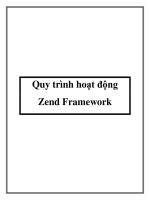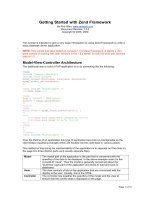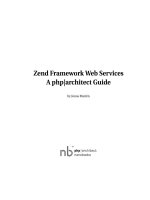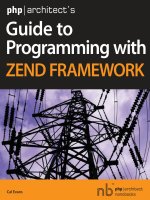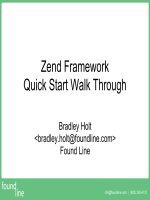Beginning zend framework
Bạn đang xem bản rút gọn của tài liệu. Xem và tải ngay bản đầy đủ của tài liệu tại đây (4.86 MB, 424 trang )
this print for content only—size & color not accurate
BOOKS FOR PROFESSIONALS BY PROFESSIONALS
®
Beginning Zend Framework
Dear Reader,
I began writing Beginning Zend Framework with one clear goal in mind: to get
PHP developers interested in Zend Framework. This book is not a beginner’s
guide to PHP; it is a beginner’s guide to Zend Framework. My goal was to write
a step-by-step guide that is fun to read, while providing enough insight into
the process and the power of Zend Framework.
After you have read this book, you will be equipped to build small-to medi-
um-scale applications using Zend Framework. I’ll show you how to do the
following:
• Install Zend Framework in any environment so you can deploy your
applications in any setup.
• Apply the MVC pattern to write flexible and efficient applications.
• Use Zend Framework to connect to a database.
• Mix external media, such as photos from Flickr, videos from YouTube, and
products from Amazon.com, with your own by using web services.
• Send e-mail to keep in touch with your users.
• Add a customized search engine to your site.
• Optimize your web application using Zend Framework’s built-in
caching tools.
You’ll soon be writing your own Zend Framework applications and seeing
the benefits it can bring to your own projects.
I hope you have as much fun reading it as I had writing it!
Armando Padilla
US $42.99
Shelve in
Programming/PHP
User level:
Beginner–Intermediate
CYAN
MAGENTA
YELLOW
BLACK
PANTONE 123 C
THE APRESS ROADMAP
Beginning PHP and MySQL,
Third Edition
The Definitive Guide to
Zend Enterprise
Beginning
Zend Framework
Pro PHP
Zend Framework
Practical Web 2.0
Applications with PHP
Pro Zend
Framework CMS
www.apress.com
SOURCE CODE ONLINE
Companion eBook
See last page for details
on $10 eBook version
ISBN 978-1-4302-1825-8
9 781430 218258
54299
Padilla
Beginning
Zend Framework
Companion
eBook Available
spine = 0.96875" 424 page count
THE EXPERT’S VOICE
®
IN OPEN SOURCE
Beginning
Zend
Framework
Armando Padilla
Learn to build professional web applications
with Zend Framework
Download at Boykma.Com
Beginning Zend Framework
■ ■ ■
Armando Padilla
Download at Boykma.Com
ii
Beginning Zend Framework
Copyright © 2009 by Armando Padilla
All rights reserved. No part of this work may be reproduced or transmitted in any form or by any means,
electronic or mechanical, including photocopying, recording, or by any information storage or retrieval
system, without the prior written permission of the copyright owner and the publisher.
ISBN-13 (pbk): 978-1-4302-1825-8
ISBN-13 (electronic): 978-1-4302-1826-5
Printed and bound in the United States of America 9 8 7 6 5 4 3 2 1
Trademarked names may appear in this book. Rather than use a trademark symbol with every occurrence
of a trademarked name, we use the names only in an editorial fashion and to the benefit of the trademark
owner, with no intention of infringement of the trademark.
Lead Editors: Steve Anglin and Matthew Moodie
Technical Reviewer: Adam DeFields
Editorial Board: Clay Andres, Steve Anglin, Mark Beckner, Ewan Buckingham, Tony Campbell, Gary
Cornell, Jonathan Gennick, Michelle Lowman, Matthew Moodie, Jeffrey Pepper, Frank
Pohlmann, Ben Renow-Clarke, Dominic Shakeshaft, Matt Wade, Tom Welsh
Project Managers: Beth Christmas and Debra Kelly
Copy Editor: Nancy Sixsmith, ConText Editorial Services
Associate Production Director: Kari Brooks-Copony
Production Editor: Ellie Fountain
Compositor: Tricia Bronkella
Indexer: BIM Indexing
Cover Designer: Kurt Krames
Manufacturing Director: Tom Debolski
Distributed to the book trade worldwide by Springer-Verlag New York, Inc., 233 Spring Street,
6th Floor, New York, NY 10013. Phone 1-800-SPRINGER, fax 201-348-4505, e-mail
, or visit .
For information on translations, please e-mail , or visit .
Apress and friends of ED books may be purchased in bulk for academic, corporate, or promotional use.
eBook versions and licenses are also available for most titles. For more information, reference our Special
Bulk Sales–eBook Licensing web page at />The information in this book is distributed on an “as is” basis, without warranty. Although every
precaution has been taken in the preparation of this work, neither the author(s) nor Apress shall have any
liability to any person or entity with respect to any loss or damage caused or alleged to be caused directly
or indirectly by the information contained in this work.
The source code for this book is available to readers at .
Download at Boykma.Com
iii
To my parents, Guillermo Padilla and Francisca Osuna. To my friend
Susannah Halweg. You have shaped the person that I am today. Thank
you.
Download at Boykma.Com
i
v
Contents at a Glance
■Contents v
■About the Author xiii
■About the Technical Reviewer xiv
■Acknowledgments xv
■Introduction xvi
■Chapter 1: Getting Started with Zend Framework 1
■Chapter 2: The Application 35
■Chapter 3:Writing Controllers Using Zend_Controller 53
■Chapter 4: Views, Forms, Filters, and Validators 85
■Chapter 5: Database Communication, Manipulation, and Display 155
■Chapter 6: Sending and Receiving E-mail 227
■Chapter 7: Web Services and Feeds 253
■Chapter 8: Creating a Search Engine Using Zend_Search_Lucene 317
■Chapter 9: Caching with Zend Framework 359
■Index 387
Download at Boykma.Com
v
Contents
■Contents v
■About the Author xiii
■About the Technical Reviewer xiv
■Acknowledgments xv
■Introduction xvi
■Chapter 1: Getting Started with Zend Framework 1
The Tools 1
Apache 2
Installing Apache on Windows 2
Installing a Mac Development Environment 8
Post-Apache Installation 11
MySQL 13
Installing MySQL on Windows 13
Configuring MySQL 16
Installing MySQL GUI Tools 18
Post-MySQL Installation 21
Creating a Test Database 22
PHP 23
Installing PHP 23
Getting PHP and Apache to Talk 23
Installing Zend Framework 25
Your First Application 27
Zend_Tool 27
Installing Zend_Tool 28
Testing the Zend_Tool Installation 29
Creating Your Project 29
Looking Under the Hood 30
Download at Boykma.Com
vi
Summary 33
■Chapter 2: The Application 35
Music Mash-Up Application 35
Mashing Up the Pieces 36
Accounts Module 36
Artists Module 36
Web Services Module 37
Designing the System 37
An Overall Look 37
Designing the Accounts Module 38
Signing Up 39
Logging In and Out 39
User Profile Page 40
User Update Page 41
Designing the Artists Module 42
Add Artist to User’s List 42
Removing an Artist from the List 43
Update Artist List 44
Artist Profile Page 45
Designing the Database 46
Accounts Table 46
Artists Table 48
Accounts_Artists Table 48
Creating Tables in MySQL 50
Summary 51
■Chapter 3: Writing Controllers Using Zend_Controller 53
Model-View-Controller Pattern 53
Why Use MVC? 53
What Is the MVC Pattern? 54
MVC Life Cycle 55
Zend Controllers 56
Controller Guidelines 59
Naming the Controller 59
Extending Zend_Controller_Action 60
Download at Boykma.Com
vii
Naming Actions 61
Routing in Zend Framework 61
Transforming URLs to Controllers/Actions 62
Dissecting the URL 62
Creating Custom URLs 63
Passing Parameters with Route 66
Request Object 68
Zend Controller Error Handling 77
Extending Error Handling 78
Setting a Different Error Handler 78
Using Error Variables in the View 79
The Model 80
Summary 82
■Chapter 4: Views, Forms, Filters, and Validators 85
Working with Views 85
A Simple Example View 86
Why You Need Views 94
Manipulating the Directory Structure 98
Adding Logic and Control to Views 101
Variable Handling 101
Looping in the View 105
If-Else Statements 107
Escaping User Input 110
Creating Your Own escape() Function 111
Advanced Escape Functionality 112
Creating Forms Using Zend_Form 115
Getting Started 115
Adding Elements to a Form 118
Formatting the Form 121
Processing the Form 123
Error Handling 126
Adding Validation and Filtering 129
Creating Form Element Objects 133
Download at Boykma.Com
viii
Creating Textarea Fields 134
Creating Password Fields 140
Creating Hidden Text Fields 140
Creating Radio Buttons 140
Creating Check Boxes 140
Creating Select Menus and Multiselect Menus 141
File Uploading 144
Implementing CAPTCHA 147
Summary 151
■Chapter 5: Database Communication, Manipulation, and Display 155
Getting Started 155
Installing PDO 156
Connecting to a Database 157
Inserting Data 160
Using Plain Old SQL (POSQL) 161
Inserting Data Without SQL 163
Database Expressions 165
Escaping Values 166
Brief Background: SQL Injection 166
Escaping User Data 166
Escaping by Using quoteInto() 168
Last Inserted ID 170
LoudBite Sign-up Page 171
LoudBite Add Artist 173
Fetching and Displaying Records 175
Using fetchAll() 176
Using fetchOne() 181
LoudBite Login Page 183
LoudBite User Profile Page 188
Deleting Records 191
Updating Records 193
Transaction Control 195
Object-Oriented SELECT Statements 198
Querying Records from Tables Using from() 199
Download at Boykma.Com
i
x
Querying Specific Columns 200
Executing Object-Oriented Statements 201
Creating Column and Table Aliases 202
Narrowing Down the Search with a WHERE Clause 204
Querying Two or More Tables using JOIN 208
Limiting and Ordering the Result Set 211
Ordering Result Sets 211
Database Expressions 213
Paginating Records 215
Using the Zend_Paginator 215
Adding Control to the Paginator 218
Paginating Database Records 223
Summary 225
■Chapter 6: Sending and Receiving E-mail 227
Setting Up Mail 227
What Is Zend_Mail? 227
Sending Your First E-mail 228
Sending E-mail Using SMTP 230
Setting More than One Recipient: Cc: and Bcc: 234
Adding a Cc: 234
Adding More than One Cc 235
Adding a Bcc: 236
Additional E-mail Getters and Setters 236
HTML E-mail 238
E-mail Attachments 239
Image File Attachment 239
Validating E-mail Addresses 242
Sending LoudBite E-mail 245
Welcome E-mail 245
Activation E-mail 247
Summary 252
■Chapter 7: Web Services and Feeds 253
Introducing Web Services 253
Download at Boykma.Com
x
Web Service Messaging 254
Representational State Transfer: REST 254
Creating a Server 255
REST Clients 258
Services Overview 259
YouTube Zend Services 260
Getting Started with YouTube Services 261
Search Features 263
Video Comments and Ratings 265
Artist Video List Module 267
Flickr and Zend_Rest_Flickr 269
Getting Started with the Flickr Service 269
Connecting to the Flickr Web Service API 270
Search Using Tags 271
Search for User 272
Search for Group Photos 273
Zend_Service_Flickr_ResultSet 273
Zend_Service_Flickr_Result 274
LoudBite: Artist Flickr Photo Stream 275
Amazon and Zend_Service_Amazon 277
Getting Started with the Amazon Service 278
Amazon.com Item Search 279
Searching for Items using ItemSearch 281
Narrowing Down the Search Using Combinations 283
Sorting the Result Set 284
Searching for Similar Products 286
Returning Product Reviews 288
Zend_Service_Amazon_EditorialReview 290
Looking Up Specific Items 290
LoudBite: Adding Amazon Product Information 292
RSS and Zend Framework
295
A Look at RSS 297
Publishing and Reading RSS 301
Zend_Feed Component 302
Download at Boykma.Com
xi
Loading RSS Documents 302
Reading and Parsing RSS 305
Parsing and Using <channel> Element Data 305
Using Item Elements 308
Creating RSS Documents 311
Summary 314
■Chapter 8: Creating a Search Engine Using Zend_Search_Lucene 317
Search Engine Components 317
Creating the Foundation 319
Creating the Index 319
Updating the Index 322
Adding Documents 323
Updating Documents 325
Deleting Documents 325
Creating Searchable Fields 327
Field Type Overview 330
Field Type: Keyword 330
Field Type: UnIndexed 332
Field Type: Binary 334
Field Type: Text 334
Field Type: UnStored 336
Populating Fields with Data 340
Parsing HTML 340
Parsing Microsoft .docx Word Documents 343
Parsing Other Formats 346
Fetching Data 346
Text-based Queries 346
Operators 346
Wildcards 347
Fuzzy Searches 347
Ranges 348
Special Characters 348
Displaying Result Sets 348
Download at Boykma.Com
xii
Limiting Results 350
Sorting the Search Result 352
Highlight Colors 353
Summary 356
■Chapter 9: Caching with Zend Framework 359
Introducing Caching 359
Caching with Zend Framework 359
Creating Cached Records 363
Caching Basic Text 366
Caching Files 368
Caching Classes 370
Caching Database Data 373
Grouping Cached Data (Tags) 375
Deleting Cached Records 378
Deleting Cached Sets 380
Integrating Zend_Cache and Third-Party Tools 382
Summary 384
■Index 387
Download at Boykma.Com
xiii
About the Author
Armando Padilla has spent the last 3.5 years working on Zend
Framework projects such as
(NBC/Universal) as
well as personal projects. His PHP experience began in 1998,
when he created small PHP web pages for Thomas Jefferson
High School (Los Angeles). Armando’s most recent work was for
NBC/Universal, where he built medium
-
to large-scale
applications.
Armando now spends much of his time working for Shine
(Yahoo!), reading the Zend Framework API, creating extensions
for the Framework, and expanding his skill set by pursuing a master’s degree in computer science.
Download at Boykma.Com
xi
v
About the Technical Reviewer
Adam DeFields is a consultant specializing in web application
development, project management, technical writing/editing, and
instructional design. He lives in Grand Rapids, Michigan, where he runs
Emanation Systems, LLC (www.emanationsystemsllc.com), an IT services
company he founded in 2002. Adam has coauthored or reviewed more
than a dozen books on various technologies, including Java, PHP, Apache,
MySQL, and Zend Framework.
Download at Boykma.Com
x
v
Acknowledgments
There were times that I felt I could not write this book. I think all first-time authors must feel this way, no
matter how knowledgeable they might be in a certain field. It’s a very humbling feeling.
I know I wouldn’t have grown from this experience without the Apress team. I want to thank all of
them. Thanks especially to Beth Christmas for putting up with my “deadline malfunctions” and having the
patience to work with me. Thanks to Steve Anglin for taking a chance and giving me the opportunity to
write this book, and a big thank you to Matthew Moodie for taking the time to lend a hand.
Download at Boykma.Com
xvi
Introduction
Welcome to Beginning Zend Framework! The primary goal of this book is to set the foundation for your
journey into Zend Framework. You can be a beginner or a seasoned developer—this book includes
something for everyone. For the Zend Framework beginner, this book covers everything from the basic
setup to answering questions about what a controller is. For the seasoned developer, it includes chapters
on the caching and the search component of Zend Framework.
What the book doesn’t include is a how-to of PHP. Because the book is entirely focused on using
PHP, you need at least a basic understanding of the language.
Overview
Following is a chapter-by-chapter breakdown—the road map.
Chapter 1: “Getting Started with Zend Framework”
You need a starting point, and there is nothing better than setting up a working development environment
to get off on the right foot. This chapter covers all the tools you need to get a simple and complex
application powered by Zend Framework up and running. It furnishes step-by-step instructions on how to
install and test each component, and finishes up by showing you how to create a small application using
Zend Framework’s Zend_Tool.
Chapter 2: “The Application”
If you’re reading this book chapter by chapter, here you will create a small application called Loudbite,
which is a small music mashup site. The application leaves plenty of room for you to expand on and is
only used for the examples. This chapter provides not only the background but also the database ERD and
overall architecture of the application.
Chapter 3: “Writing Controllers Using Zend_Controller”
Zend Framework has a unique way of controlling user requests, and this chapter covers the basic building
blocks of this process. The chapter describes the URL structure as well as how Zend Framework treats
each piece of the URL to route the user to the appropriate controller-action of the application.
Chapter 4: “Views, Forms, Filters, and Validators”
What would a Framework book be without a chapter on the crucial elements web developers create
everyday on a project? Forms! This chapter covers how Zend Framework eases the grueling tasks of
creating, validating, and filtering forms.
Download at Boykma.Com
xvii
Chapter 5: “Database Communication, Manipulation, and
Display”
Because most web applications require a persistent storage unit such as a database, this chapter looks at
the database support that Zend Framework provides. This chapter covers using PDO, creating statements,
executing statements, retrieving information, using object-oriented statements, and working with built-in
pagination support.
Chapter 6: “Sending and Receiving E-mail”
E-mail! Zend Framework did not stop at database and typical web layer functions; it also created a solid e-
mail component for sending and retrieving e-mail. This chapter shows you how to create e-mail, how to
send e-mail using text and HTML, and how to send attachments.
Chapter 7: “Web Services and Feeds”
For today’s developers, REST and RSS feeds are part of the standard vernacular. So it’s no surprise that
Zend Framework has included support for these services and has gone one step further by providing
wrappers for your favorite open APIs. This chapter covers how Zend Framework works with the current
web service alphabet soup: REST. It also shows you how to create web services, call web services, and
create and consume feeds.
Chapter 8: “Creating a Search Engine Using
Zend_Search_Lucene”
This chapter discusses search engines and how Zend Framework has packaged a proven search engine
such as Lucene. It takes you step by step into creating each of the building blocks of the search engine:
from creating an index to adding content using the built-in wrappers for Word, HTML documents, and
Excel files.
Chapter 9: “Caching with Zend Framework”
The last chapter discusses how you can get that extra juice by speeding up applications using cache. You
will learn how to successfully implement the Zend Caching component for standard HTML to database
records.
Contacting the Author
As a reader of technical manuals, I tend to have more questions about topics covered in the book after
each chapter. If you encounter any questions, I’m here to help. You can reach me directly at
or you can find me posting Zend Framework–related items as well as
answering any questions you may have with this book on this site: www.beginningzendframework.com.
All source code for this book can be found on the Apress web site as well as on
and . Enjoy!
Download at Boykma.Com
Download at Boykma.Com
C H A P T E R 1
■ ■ ■
1
Getting Started with Zend
Framework
Regardless of your programming skills, you have decided to make your way into the Zend Framework
world. Some of you might be new to programming; others might be seasoned developers heading a large
team. Regardless of your status or reasons why you want to enter the Zend Framework world, everyone
starts on the same page. Yes, stop your groaning; that means setting up the environment and dealing
with the technology that will get you up and running toward building your application powered by Zend
Framework.
You might be wondering why you need to go through this process. That’s fair; when I started
developing PHP applications, I asked the same question—but I continued to follow the steps to set up
the environment. Looking back to my experience, I can say that setting up the environment will give you
a few things right away. For new developers, it will introduce the technology Zend Framework needs to
successfully start developing applications. Think about it like this: if I gave you a box of tools and asked
you to build a house, how on earth would you go about accomplishing that task if you didn’t know how
to use each of the tools in the box? So you also need to learn which tools you need to build your
figurative house: a Zend Framework application.
If you know which tools are needed to run applications, you will understand the limitations of
those applications. If your boss came up to you, stared into your eyes, and (besides telling you that you
rock) said, “I need a Zend Framework application that will handle ten million users per month, a few
hundred thousand hits per minute and have a response time of less than a second. Can you do it?” You
should be able to tell him, “Yeah, I rock. What’s new?” You can also say, “Yes! You’ll have it in a month,
with all the bells and whistles you asked for.” I can’t promise that Zend Framework will handle 1,000 hits
per second because that’s for your load balancer to handle, but I do promise that Zend Framework will
make it fun for you to deliver the product on time.
The goal of this chapter is to set up a development environment with all the free tools available:
• Apache 2.2
• MySQL 5.1 or later
• PHP 5.2.4 or later.
• Zend Framework 1.8
You will also create your first Hello World application powered by Zend Framework and review
the basic components required to power all Zend Framework applications efficiently.
The Tools
Let’s open up that toolbox now and see what’s in there. You see a hammer, some nails, and a blow torch,
enough to start a house. Don’t worry; installing your tools will be an easy process. If you’re a senior
developer, take a look at the list of software and determine whether you need to read this section or not.
If you feel comfortable installing the tools on your own, or if you already have a development
Download at Boykma.Com
CHAPTER 1 ■ GETTING STARTED WITH ZEND FRAMEWORK
2
environment that will run the required PHP version, skip these few sections and start with the “Installing
Zend Framework” section later in this chapter.
Regardless of your experience, take the time to read through the installation and setup process
of Zend Framework and create the small Hello World application outlined in this chapter. Trust me; it
will prove invaluable to read the section and create the test application.
Let’s begin installing the development environment step by step.
■ Note Windows users should continue reading; Mac users can skip to the section called “Installing a Mac
Development Environment.” We don’t cover Linux/Unix installation because your distribution will have its own way
of installing Apache, MySQL, and PHP (although we do discuss installing Zend Framework). Refer to your
distribution’s documentation if you are unsure or need more help.
Apache
You will start with the base software that most web applications need: Apache. Without Apache, most
web applications installed on computers could not communicate with the world.
Installing Apache on Windows
As of this writing, Apache has released version 2.2.x of its free web server. If you have a hosted web server
you can use it; depending on your setup you might need to skip this section and head toward the
“Installing Zend Framework” section. For everyone else, let’s start the process of installing Apache on
your computer.
Pull up the Apache web site (), click the “Download! from a mirror” link on
the left side, and select from one of the mirror sites shown on the following page. Windows users:
download the Windows installer file apache_2.2.x-win32-x86-no_ssl-r2.msi.
After the file has completely downloaded, open the installer. The initial window will be a
security warning (see Figure 1-1). Depending on your version of Windows, ignore it and click Run to get
into the installation.
Download at Boykma.Com
CHAPTER 1 ■ GETTING STARTED WITH ZEND FRAMEWORK
3
Figure 1-1. Windows installation security warning
The next window is the Apache setup window. If you have a previous version of Apache
installed, you might see another pop-up window that asks you to remove the previous installation before
you begin the new one.
■ Note If you don’t want to upgrade, skip the steps dealing with Apache.
Click Next on the initial window (see Figure 1-2).
Download at Boykma.Com
CHAPTER 1 ■ GETTING STARTED WITH ZEND FRAMEWORK
4
Figure 1-2. Apache installation welcome window
In the License Agreement window that displays, select “I accept the terms in the license
agreement” and click Next (see Figure 1-3). Click Next in the following window.
Download at Boykma.Com
CHAPTER 1 ■ GETTING STARTED WITH ZEND FRAMEWORK
5
Figure 1-3. Apache server terms and conditions window
The Server Information window displays (see Figure 1-4). You need to fill in all the fields.
Because this will be a web server operating on your desktop, you can add any domain name and network
name into the Network Domain and Server Name fields, respectively. I chose to enter localhost for both
of those fields. Enter your e-mail address in the Administrator’s Email Address field and then click Next.
Download at Boykma.Com
